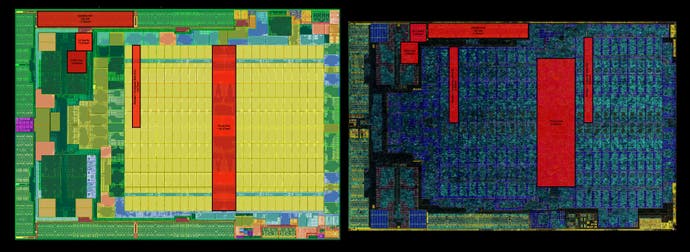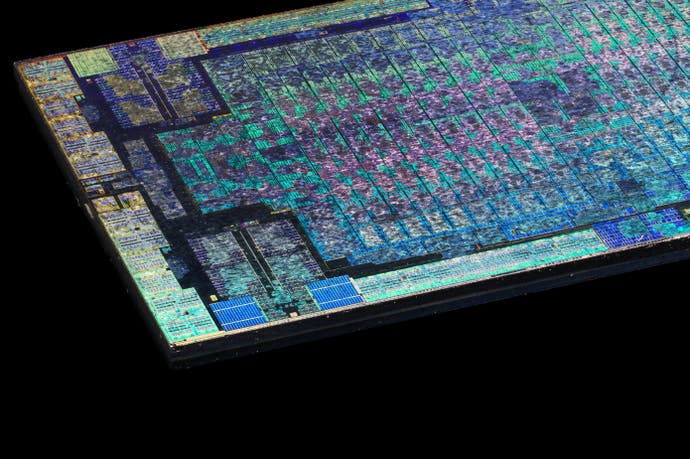PS4 Pro and Xbox One X processors compared at the silicon level
And the results are closer than you might think.
We knew the spec many months before its launch and gained insights on its core design from its system architect, but only now can we see the physical layout of PlayStation 4 Pro's central processor. The key takeaway? Add some memory controllers plus an extra four AMD Radeon compute units and the basic layout of the Pro's chip is very similar indeed to the physical make-up of the Scorpio Engine found within Microsoft's Xbox One X. Putting the two chips side by side reveals just how close today's consoles are, and how innovative design choices and more memory pushed Microsoft's hardware ahead of its rival.
Quite how we have photographic imagery of PS4 Pro's silicon is a fascinating story in itself. For a while now, we've been tracking the this Flickr account, which produces some truly remarkable work. Essentially, 'Fritzchens Fritz' takes a processor from its host mainboard, uses extreme heat to prise the chip away from its housing, then uses a remarkable process taking several hours to remove the layers of the chip, exposing the physical make-up of the processor itself, which is then photographed under extreme magnification. It's a process reliant on hardware donations, so from a somewhat selfish perspective, if anyone has a defective Xbox One S or PS4 Slim they can offer up for the cause, well, we'd love the chance to see the composition of these second-gen smaller, cooler 16nm processors.
But returning to the subject at hand, this new look at the Pro's physical layout offers up some interesting insights. For example, when the specs were first revealed, the amount of hardware shaders looked very much like AMD's Polaris 10 processor as found in today's RX 580, which has 36 GPU compute units giving a total of 2304 shaders.
However, as per our conversation with Mark Cerny in the run-up to the Pro's launch, what we actual get is an entirely unique design: more of a butterfly arrangement, in fact with the original PS4 GPU mirrored, in effect. What is curious is that the area taken up by the second array of CUs is actually larger than the first. A quick count reveals 40 CUs in total (vs the 36 total on AMD's Polaris) with four disabled so that chips with minor silicon defects can be saved from the production line and still used in final hardware.
The work carried out by Fritzchens Fritz also gives us a confirmed die-size for the chip at 325mm2, just a small amount larger than prior guestimates derived from motherboard photography and around 9.7 per cent smaller than Xbox One X's 360mm2 processor. However, looking at the two processors side-by-side, it's fascinating to see just how similar they are. There's a comparison image below, but if you're having trouble making out the detail, here's a closer look.
Architecturally similar CPU clusters occupy the same space and area (though Xbox One X does double up on cache), and in both cases, the two banks of compute units are separated by the front end. Each individual CU on the Pro is around 15 per cent larger than the Scorpio equivalent, perhaps down to Microsoft retaining the existing 'Southern Islands' technology while Sony opts for a more modern CU design with new instructions.
The bottom line though? Microsoft achieved a 42 per cent increase in GPU compute power compared to PS4 Pro, but at the hardware level, there are only four more CUs in play. Innovation in the Xbox One X's design involved pushing its silicon to much higher clocks speeds: Pro's 911MHz GPU compares with X's 1172MHz, a 28.6 per cent increase. This was achieved via Microsoft's Hovis Methold - pairing the voltage requirements of the chip with the mainboard - and a much bigger investment in cooling. An additional year for chip manufacturer TSMC to work with its 16nm FinFET process can't have hurt either.

Of course, the X's other advantage is memory related: there's also the increase in memory bandwidth, which in turn allows for 4GB of additional RAM. The two additional memory controllers can be seen on the silicon layout, where the Scorpio Engine's 384-bit bus comprises of six 64-bit controllers, compared to Pro's four.
So there's an argument here that a good proportion of the difference between the two consoles is derived from aspects of the spec outside of the processor itself - more memory and innovation in cooling and power management. However, we should remember that die shots of the silicon can only reveal the basic fundamental building blocks of each design. Of course, there's a degree of commonality in fact that both are semi-custom AMD designs, but you won't see the GPU customisations Microsoft carried out, nor will you see the custom hardware checkerboarding support built into PS4 Pro's processor. It'll also be challenging to see that the Pro features 64 ROPs, up against Xbox One X's 32.
Leaked documentation from the Sony SDK confirms this, and likely it's a factor of the platform holder adopting a 'mirror image' strategy on the GPU to ensure compatibility with the base system - the 32 ROPs of the original PS4 is doubled up along with everything else. As things stand, doubling up on ROPs is an intriguing postscript to what we know about the established Pro spec, but the docs also confirm that it's theoretically impossible to fully utilise them - the memory bandwidth just isn't there.
In the here and now, we can safely assume that both Sony and Microsoft are moving on to the core design of their next-gen successors, which become viable from a manufacturing perspective in 2019, when next-gen 7nm processor fabrication is expected to be mature enough to accommodate the demands of a new console launch. And with the arrival of AMD's Ryzen/Vega-based APUs, launching today (with Digital Foundry review coverage to follow), we may well be getting our first look at the building blocks of tomorrow's PlayStation and Xbox. Based on a revised 14nmFF process, AMD has integrated a quad-core Ryzen block and 11 Vega compute units in an area approximately 210mm2. Scaling down those components to what we expect from the new 7nm process on a similar area used by PS4 Pro and Xbox One X offers up some fascinating options for the platform holders - something we'll be returning to soon.










